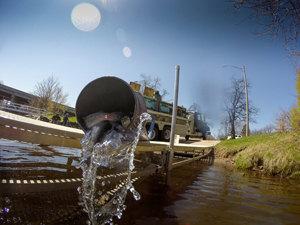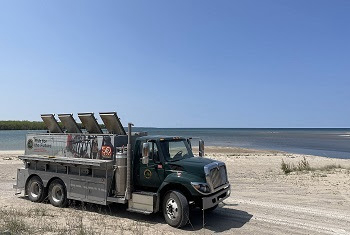More than 20 million fish stocked this spring means lots of opportunity
 The Department of Natural Resources today announced the final totals from its spring fish-stocking efforts. DNR fisheries staff stocked a total of 20,099,988 fish that weighed more than 325 tons and consisted of nine different species and one hybrid.
The Department of Natural Resources today announced the final totals from its spring fish-stocking efforts. DNR fisheries staff stocked a total of 20,099,988 fish that weighed more than 325 tons and consisted of nine different species and one hybrid.
To complete this task, staff took more than 370 stocking trips to 732 stocking sites, traveling more than 100,000 miles over the course of 2,556 hours using 17 specialized stocking trucks.
“It was another outstanding spring stocking season that will bring significant benefits and fishing opportunities to Michigan,” said Ed Eisch, DNR fish production manager. “Thanks to the hard work and dedication of our staff, fish were reared and delivered to stocking sites in excellent condition. The numbers produced and stocked were right on target for almost all areas.”
The number and type of fish stocked vary by hatchery, as each location’s ability to rear fish varies because of water supplies and temperature. In Michigan there are six state and two cooperative hatcheries that work together to produce the species, strain and size of fish needed by fisheries managers. These fish must then be delivered at a specific time and location for stocking to ensure their success. Each hatchery stocked the following fish this spring:
- Marquette State Fish Hatchery (near Marquette) stocked 610,194 yearling lake trout, brook trout and splake (a cross of lake trout and brook trout) that in total weighed 61,257 pounds. This hatchery stocked a total of 119 inland and Great Lakes sites using 56 trips that required driving 16,409 miles over 410 hours.
- Thompson State Fish Hatchery (near Manistique) stocked 8,003,760 fish that included walleye fry, yearling steelhead and brown trout, and spring fingerling Chinook salmon. These fish weighed 127,801 pounds in total. This hatchery stocked 103 sites (the majority located on the Great Lakes) using 75 trips that required driving 19,472 miles over 508 hours.
- Oden State Fish Hatchery (near Petoskey) stocked 671,604 yearling brown trout and rainbow trout that in total weighed 93,423 pounds. This hatchery stocked 143 inland and Great Lakes sites using 69 trips that required driving 19,472 miles over 533 hours.
- Harrietta State Fish Hatchery (in Harrietta) stocked 1,213,899 yearling brown trout and rainbow trout that in total weighed 114,540 pounds. This hatchery stocked 267 sites (the majority located inland) using 84 trips that required driving 23,261 miles over 588 hours.
- Platte River State Fish Hatchery (near Honor) stocked 2,556,540 fish that included yearling Atlantic salmon and coho salmon, spring fingerling Chinook salmon and walleye fry that in total weighed 131,472 pounds. This hatchery stocked 39 sites (the majority located on the Great Lakes) using 39 trips that required driving 8,012 miles over 199 hours.
- Wolf Lake State Fish Hatchery (near Kalamazoo) stocked 7,004,084 fish that included walleye fry, yearling steelhead and spring fingerling Chinook salmon that in total weighed 118,648 pounds. This hatchery stocked 60 sites (the majority located on the Great Lakes) using 49 trips that required driving 13,451 miles over 317 hours.
- The cooperative teaching hatchery at Lake Superior State University (in Sault Ste. Marie) stocked 39,907 Atlantic salmon weighing 3,868 pounds into the St. Marys River.
In addition, Wolf Lake, Platte River and Thompson state fish hatcheries transferred millions of walleye fry to management unit rearing ponds for grow-out and eventual stocking this summer and fall. Several management units also stocked and transferred many species of cool- and warm-water fish within their units.
Fish stocking is a critical DNR activity. These efforts help pump between $2.4 billion and $4.2 billion into the state’s economy through the sportfishing industry and associated businesses. As a frame of reference, spring 2014 stocking efforts totaled 19.3 million fish.
Fish are reared in Michigan’s state fish hatcheries anywhere from one month to one and a half years before they are stocked. Some of the Chinook salmon and steelhead are transferred from the hatcheries to imprinting net pens for the final few weeks before they are released. This acclimation period helps the fish imprint on the receiving waters which increases the likelihood they will return to the stocking site when they reach sexual maturity.
“Our imprinting net pens are run cooperatively by several different groups around the state,” Eisch said. “This is an excellent example of how the resource benefits from strategic partnerships that have been built over time.”
Some hatcheries will provide fish for a few additional stockings (consisting of brook trout, Atlantic salmon, lake sturgeon and muskellunge) to be made this fall. The lake sturgeon will come from the DNR’s cooperative hatchery in Tower that is operated with Michigan State University.
The DNR welcomes visitors to its state fish hatcheries and interpretative centers to witness first-hand the fish-rearing process and to learn about Michigan’s remarkable waters. For more information, visit michigan.gov/hatcheries.
The DNR maintains a public database of fish-stocking records, which can be reviewed at michigandnr.com/fishstock.






